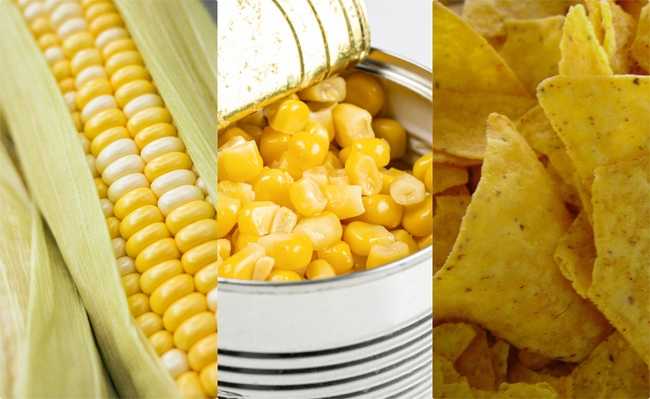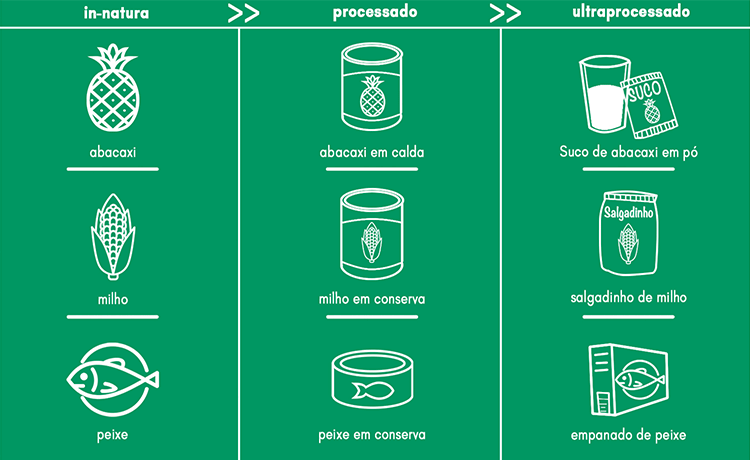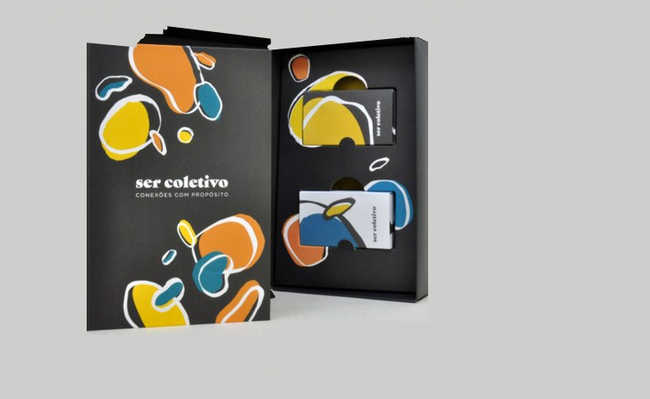What are fresh, processed and ultra-processed foods
The corn in nature, canned and savory snacks are examples of the same food in different stages of processing

Pasted and resized images respectively of Phoenix Han, Marco Verch and Leon Brooks
The history of food processing starts from the need (dated back a long time ago) that humanity had to conserve food for as long as possible, in order to ensure survival in periods of scarcity, such as winters or severe droughts.
The first elements used to preserve food were the heat of the sun, fire and ice (in regions where temperatures were lower). However, the specific date when humanity began conservation processes is lost in history. Archeological studies in caves in China assume that humans in Beijing, between 250,000 and 500,000 years ago, already used fire to heat and heat or cook raw meats and vegetables.
- Preservatives: what are they, what types and dangers
Over time, new techniques were developed to preserve food, such as pasteurization, lyophilization, addition of natural preservatives (salt, sugar, oil, among others). We have reached a level where the technologies used by the food industry go far beyond food conservation - today we have foods available that add practicality and satisfaction, but not necessarily the function of meeting human nutritional needs.
The vast majority of the food we consume undergoes some type of processing - the definition of processing is given by the set of methods that make the food edible, guarantee food safety and preserve the food for a certain period. Often the processing of a particular food is essential to guarantee that there will be no food poisoning when consuming it.
An example is the processing of palm heart, which needs to be preserved in acidified brine (pH below 4.5), with the addition of preservatives and undergo thermal treatment (sterilization, temperature of 121°C) to eliminate the bacteria spores Clostridium botulinum. The bacterium is a producer of a neurotoxin that, if not treated quickly, can be lethal.
- Consuming juçara palm hearts contributes to deforestation
With the advent of industrialization, food processing grew rapidly and there was a great transformation, thanks to food science and new technologies. Given these changes, there is a need for a rigorous examination of the impacts that all forms of processing have on eating habits and patterns, and on nutrition, health and well-being.
The result of a partnership between the Center for Epidemiological Research in Nutrition and Health (Nupens FSP-USP) and the Ministry of Health, the Food Guide for the Brazilian Population was launched in November 2014 and proposes a new classification of foods, based on the degree of processing, replacing the food pyramid classification that has been abolished since 2010. The guide is internationally recognized, and was named “the best nutritional guidelines in the world”. The foods were divided into four groups and will be presented below.

Source: Food Guide for the Brazilian Population. Infographics by Larissa Kimie Enohata/Portal eCycle. Icons: ohyeahicon pineapple, corn by Khalay Chio, fish by alex setyawan and tuna can by throwaway icons in Noun Project
Group 1 - Food in nature (unprocessed) or minimally processed
The foods in nature they are obtained directly from plants or animals and do not undergo any change after leaving nature. Minimally processed foods correspond to foods in nature which have been subjected to cleaning processes, removal of inedible or undesirable parts, fractionation, milling, drying, fermentation, pasteurization, refrigeration, freezing and similar processes that do not involve the aggregation of salt, sugar, oils, fats or other substances to the original food .
The goal of minimal processing is to make food more available and accessible, and often safer and more palatable. The foods that are part of this group are: grains, nuts, vegetables, fruits and vegetables, roots and tubers, teas, coffee, herbal infusion, tap and bottled water - see other examples.
- Six natural sweetener options without synthetic sweetener
Group 2 - Culinary and industrial ingredients
The second group includes substances extracted and purified by industry from food in nature or obtained directly from nature in order to produce culinary ingredients for the food industry or the final consumer. The processes used are: pressure, milling, refining, hydrogenation and hydrolysis, use of enzymes and additives. These processes are different from those used in obtaining minimally processed foods because they radically change the nature of the original food.
Typically, Group 2 food products are not consumed alone, and have higher energy density and lower nutrient density compared to the whole foods from which they were extracted. They are used in homes, in restaurants, in food preparation in nature or minimally processed to create varied and tasty culinary preparations, including broths and soups, salads, pies, breads, cakes, sweets and preserves, and also in the industry for the production of ultra-processed foods.
- Corn and fructose syrup: tasty but careful
- Soybeans: is it good or bad?
Group 2 is composed of the following foods: starches and flours, oils and fats, salts, sweeteners, industrial ingredients such as fructose, corn syrup, lactose and soy protein.
Group 3 - Processed foods
Processed foods are manufactured by industry with the addition of salt, sugar or other culinary substances to foods in nature to make them durable and more palatable. They are products derived directly from food and are recognized as versions of the original foods. They are usually consumed as part or accompaniment of culinary preparations based on minimally processed foods.
Some examples of processed foods are: carrots, cucumbers, peas, hearts of palm, onions and cauliflower preserved in brine or in a salt and vinegar solution; tomato extracts or concentrates (with salt and/or sugar); fruit in syrup and candied fruit; dried meat and bacon; canned sardines and tuna; cheeses; and breads made from wheat flour, yeast, water and salt.
Group 4 - Ultra-processed foods
Ultra-processed foods, products that are ready for consumption, requiring heating or not, are industrial formulations made entirely or mostly from substances extracted from foods (oils, fats, sugar, starch, proteins), derived from food constituents (hydrogenated fats, starch modified) or synthesized in the laboratory on the basis of organic materials such as oil and charcoal (dyes, flavourings, flavor enhancers and various types of additives used to provide products with attractive sensory properties).
Manufacturing techniques include extrusion, molding, and pre-processing by frying or baking. The goal of ultra-processing is to make food attractive, accessible, palatable, have a long shelf life and practicality. Group 4 can be subdivided into two categories:
Snacks and desserts:
Breads, granola bars, biscuits, chips, cakes, sweets, ice cream and soft drinks.
Products that require pre-preparation (heating):
Ready-made dishes (frozen), pasta, sausages, nuggets, sticks of fish, dehydrated soups, infant formula and baby food.
The latest report presented by the Pan American Health Organization (PAHO) “Ultra-processed foods and beverages in Latin America: trends, impact on obesity and implications for public policy”, carried out between 2000 and 2013 in 13 Latin American countries (Argentina , Bolivia, Brazil, Chile, Colombia, Costa Rica, Ecuador, Guatemala, Mexico, Peru, Dominican Republic, Uruguay and Venezuela) found that there was an increase in the per capita sale of ultra-processed products, accompanied by an increase in the average body weight of their populations. countries. This is an indicator that these products are one of the main factors in the increased rates of overweight and obesity in the region. However, in North American countries, there was a decline of 9.8% in sales of ultra-processed foods.
There is a consensus between the World Health Organization (WHO), the Food and Agriculture Organization of the United Nations (FAO) and the World Cancer Research Fund that the main factors that promote weight gain and obesity are the development of non-communicable diseases (NCDs) are: high intake of foods with few nutrients and high energy value (ultra-processed foods), routine consumption of sugary drinks and insufficient physical activity. Given the increased consumption of ultra-processed foods and their possible impacts on human health, it is necessary to create public policies that reduce access to this type of food. An example to be cited was the application of fees on all sweetened beverages and all snacks high in sugar and fat, by the government of Mexico.
According to the Food Guide for the Brazilian Population, ultra-processed foods have other negative impacts that go far beyond human health and nutrition, and, therefore, the consumption of these foods should be avoided.
Impact on culture
Brands, packaging, labels and content of ultra-processed foods tend to be identical around the world. The best-known brands are promoted by million-dollar and very aggressive advertising campaigns, including the launch each year of hundreds of products that suggest a false sense of diversity. Faced with these campaigns, genuine food cultures are seen as uninteresting, especially by young people. The consequence is the promotion of the desire to consume more and more so that people have the feeling of belonging to a modern and superior culture.
Impact on social life
Ultra-processed foods are formulated and packaged to be consumed without the need for any preparation, anytime and anywhere. Its use makes food preparation, meal table and food sharing less important. Its consumption often occurs without a fixed time, often when the person watches television or works at the computer, when he walks on the street, drives a vehicle or talks on the telephone, and at other times of relative isolation. The “social interaction” usually shown in advertisements for these products hides what actually takes place.
Impact on the environment
The manufacture, distribution and sale of ultra-processed food is potentially harmful to the environment and, depending on the scale of its production, threatens the sustainability of the planet. This is symbolically demonstrated in the piles of packaging of these products discarded in the environment, many are not biodegradable, disfigure the landscape and require the increasing use of new spaces and new and expensive waste management technologies. The demand for sugar, vegetable oils and other raw materials common in the manufacture of ultra-processed foods encourages pesticide-dependent monocultures and intense use of chemical fertilizers and water, to the detriment of agricultural diversification. The sequence of processes involved in the manufacture, distribution and sale of these products involves long transport routes and, therefore, great expenditure of energy and emission of pollutants. The amount of water used in the various stages of its production is immense. The common consequence is the degradation and pollution of the environment, the reduction of biodiversity and the compromising of reserves of water, energy and many other natural resources.
Finally, the Food Guide for the Brazilian Population suggests four recommendations and a golden rule for a healthy and balanced diet.
- make the food in nature and minimally processed the basis of their food.
- Use oils, fats, salt and sugar in small amounts when seasoning and cooking food and creating culinary preparations.
- Limit the use of processed foods by consuming them in small amounts, as ingredients in culinary preparations or as part of food-based meals in nature or minimally processed.
- Avoid ultra-processed foods.
- The golden rule. Always prefer food in nature or minimally processed and culinary preparations to ultra-processed foods.
It is also very important that food in nature or minimally processed products that are part of their consumption are organic.










